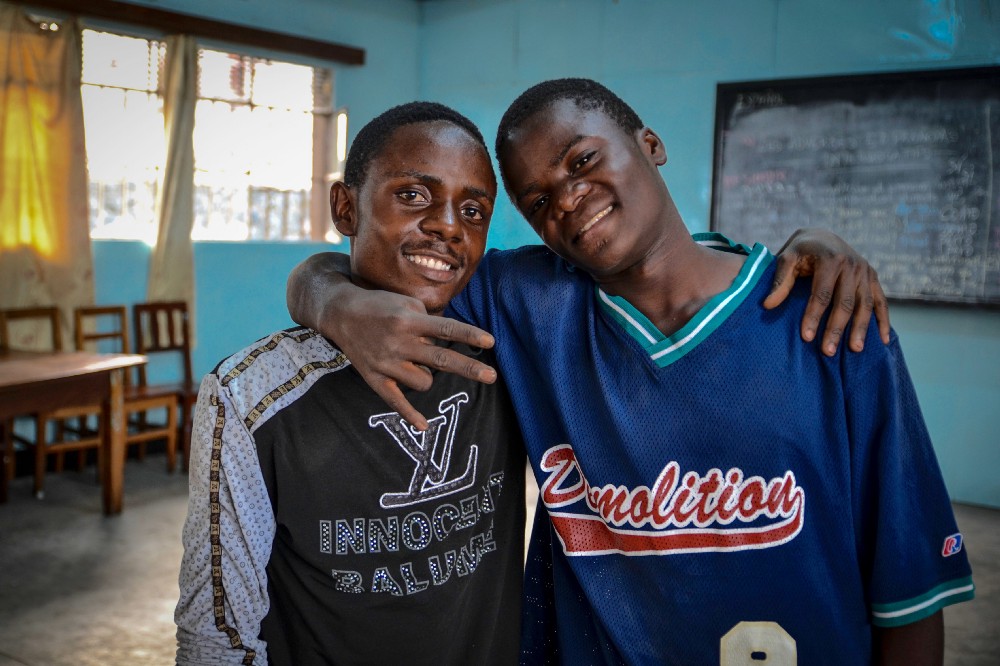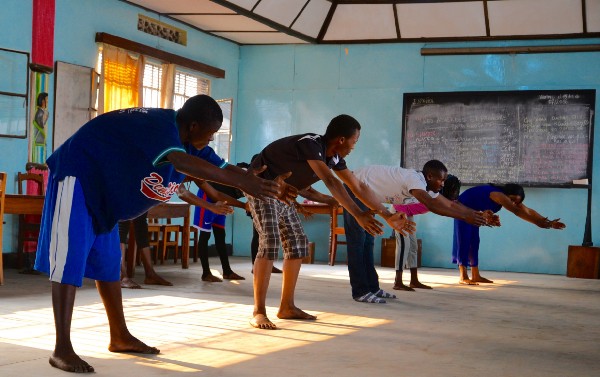Two rows of dancers arch their backs into position, arms outstretched. A steady drum beat sets the pace as a singer wails about the legacy of colonization that caused many of Africa’s woes in Swahili. As the tempo picks up, the dancers writhe on the floor in sync.
A solitary drum beat calls a soloist from the group in the middle of the routine. Christian Boley strikes a pose, his self-choreographed moves telling the story of the Democratic Republic of the Congo (DRC)’s tumultuous history with every step.

Like many of his compatriots, Boley lost family members and friends to violence during the Second Congo War, memories he is hesitant to speak about. Waged between 1998 and 2003, the conflict and humanitarian crisis it sparked may have left as many as 5.4 million people dead by 2008. A tall and muscular 27-year-old, the young man says he has also had to evade recruiters for armed groups active in the region.

(Photo: Kait Bolongaro)
When he dances, Boley tries to use the entire space. Huddled on the floor, shaking, his face full of sadness, he is reliving the fear created by conflict during his childhood. Then, he stretches out his arms and legs, forming a star, an example of what he hopes is Congo’s bright future.
“All of these experiences inspire me and push me to become the best dancer possible,” he says, twisting his wooden necklace with his fingers, referring to his memories of conflict. “When people see me dance, I want them to be proud to be Congolese.”
Like most of his classmates, Boley had never been inside a dance studio four years ago. Now, he performs regularly around Goma, the capital of North Kivu, as part of a local dance troupe, and is going to Senegal this summer to study the art.

While data is limited, Goma dancers say interest in dance has grown in the country in recent years. In Goma, most youth centers offer courses — Congolese students are particularly interested in contemporary and traditional classes, according toBelamy Paluku, co-founder of the Goma Cultural Center, where Boley attends classes. “Dancers and musicians used to have a reputation of being deviant in Congo only a few years ago. Now young people actually see the arts positively,” Paluku says.

Dr. Kenneth Wilson, a professor of medicine at Duke University, says dance, especially traditional Congolese versions, also has therapeutic properties. Wilson co-authored a study on an adapted Ngoma dance ritual from Bantu peoples across Africa, some of whom live in the DRC. The research team found that chronically ill patients said they benefited from the exercises and began to feel connected to something larger than themselves. Participants also said they felt decreases in feelings of depression and anxiety.
“In the Ngoma tradition, group bonding seems to be an important part of the tradition and emotionally supporting each other by coming together,” Wilson says.

(Photo: Kait Bolongaro)
After Boley wraps up his solo, his nine classmates fall back into two lines. Twenty-one-year-old Samantha Syamasamba sets the pace on the far left of the group. Dressed in a bright blue jumpsuit, she sways her hips back and forth in time with the rhythm. She’s only been dancing for a year — she used to dance at home when no one was watching.
“Being a woman in the DRC can be tough, but I don’t see gender on the dance floor,” she says. “Dancing has made me physically and mentally stronger. I have become more assertive and confident.”

Student Lifeke Mboyo runs through the new choreography after practice. He is determined to get every move right, even if he can’t hear the music. Mboyo was born deaf. Like most people living with disabilities in Congo, he has felt excluded from Congolese society his entire life and didn’t have the opportunity to attend a mainstream school due to the lack of facilities to accommodate him.
With the help of a friend who knows sign language, Mboyo keeps up with his classmates.
He says he finds turns difficult, but most of his steps are on time with the music. “This is my first interview,” he says. “But it won’t be my last.”





